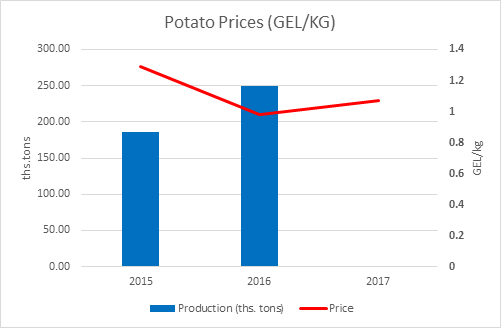Indexes
 30
September
2017
30
September
2017

 30
September
2017
30
September
2017
By the end of September, ISET’s Retail Food Price Index increased by 10.1% y/y (compared to September 2016). On a monthly basis (compared to August 2017), retail food prices slightly decreased, by 0.5%. The largest bi-weekly price changes were recorded for vegetables. The biggest price increases were observed for eggplant (19.6%), cucumber (16.7%), and potatoes (10.3%). Prices dropped the most for tomatoes (-18%), greens (-15.7%), and cabbage (-11.4%).
During the last three years, potato prices have been exhibiting an interesting trend. In 2015, they were relatively high (1.29 GEL). In 2016, prices decreased by 24% (down to 0.98 GEL) and then went up again by 10% in September 2017.

Such periodic fluctuations, when prices increase and decrease consecutively, might be explained by the cobweb model concept. According to the cobweb model, producers' expectations about future prices are assumed to be based on their observations of prices in the past. Price expectations obviously affect production-related decisions. Thus farmers, who observed high potato prices in 2015, decided to plant more potatoes with an expectation of high prices and, therefore, high profits in the next year (2016). However, increased supply due to increased production in 2016 caused a decrease in prices. If the cobweb model holds, then the increase in the potato prices observed in 2017 should be paired with decreased production. One can check if that holds true once the figures on potato production are available at the end of the year.
Since price is not the only determinant of production, it is important to consider other factors as well. The International Potato Center (known by its Spanish acronym CIP) has started to explore the potential of Georgia’s potato sector, which might lead to more research and investment, and ultimately higher outputs.





